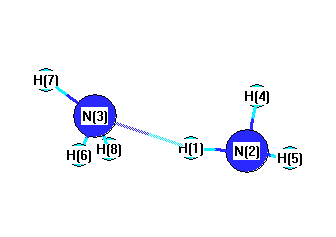Vibrational Frequencies calculated at B3LYP/aug-cc-pVTZ
| Mode Number |
Symmetry |
Frequency
(cm-1) |
Scaled Frequency
(cm-1) |
IR Intensities
(km mol-1) |
Raman Act
(Å4/u) |
Dep P |
Dep U |
|---|
| 1 |
Ag |
3574 |
3458 |
0.00 |
|
|
|
| 2 |
Ag |
3458 |
3346 |
0.00 |
|
|
|
| 3 |
Ag |
1671 |
1616 |
0.00 |
|
|
|
| 4 |
Ag |
1061 |
1026 |
0.00 |
|
|
|
| 5 |
Ag |
409 |
396 |
0.00 |
|
|
|
| 6 |
Ag |
119 |
115 |
0.00 |
|
|
|
| 7 |
Au |
3587 |
3470 |
8.30 |
|
|
|
| 8 |
Au |
1679 |
1624 |
22.65 |
|
|
|
| 9 |
Au |
206 |
199 |
70.75 |
|
|
|
| 10 |
Au |
82 |
79 |
24.17 |
|
|
|
| 11 |
Bg |
3587 |
3470 |
0.00 |
|
|
|
| 12 |
Bg |
1668 |
1614 |
0.00 |
|
|
|
| 13 |
Bg |
107 |
103 |
0.00 |
|
|
|
| 14 |
Bu |
3574 |
3458 |
41.14 |
|
|
|
| 15 |
Bu |
3460 |
3347 |
27.73 |
|
|
|
| 16 |
Bu |
1654 |
1600 |
20.50 |
|
|
|
| 17 |
Bu |
1036 |
1002 |
307.50 |
|
|
|
| 18 |
Bu |
79i |
77i |
198.10 |
|
|
|
Unscaled Zero Point Vibrational Energy (zpe) 15425.0 cm
-1
Scaled (by 0.9675) Zero Point Vibrational Energy (zpe) 14923.7 cm
-1
See section
III.C.1 List or set vibrational scaling factors
to change the scale factors used here.
See section
III.C.2
Calculate a vibrational scaling factor for a given set of molecules
to determine the least squares best scaling factor.
Charges, Dipole, Quadrupole and Polarizability
Charges from optimized geometry at B3LYP/aug-cc-pVTZ
Charges (e)
| Number |
Element |
Mulliken |
CHELPG |
AIM |
ESP |
| 1 |
H |
0.185 |
|
|
|
| 2 |
N |
-0.437 |
|
|
|
| 3 |
N |
-0.437 |
|
|
|
| 4 |
H |
0.126 |
|
|
|
| 5 |
H |
0.126 |
|
|
|
| 6 |
H |
0.185 |
|
|
|
| 7 |
H |
0.126 |
|
|
|
| 8 |
H |
0.126 |
|
|
|
Electric dipole moments
Electric dipole components in Debye
(What's a Debye? See section
VII.A.3)
| |
x |
y |
z |
Total |
| |
0.000 |
0.000 |
0.000 |
0.000 |
| CHELPG |
|
|
|
|
| AIM |
|
|
|
|
| ESP |
|
|
|
|
Electric Quadrupole moment
Quadrupole components in D Å
Polarizabilities
Components of the polarizability tensor.
Units are
Å
3 (Angstrom cubed)
Change units.
| |
x |
y |
z |
| x |
0.000 |
0.000 |
0.000 |
| y |
0.000 |
0.000 |
0.000 |
| z |
0.000 |
0.000 |
0.000 |
<r2> (average value of r
2) Å
2
| <r2> |
69.528 |
| (<r2>)1/2 |
8.338 |
